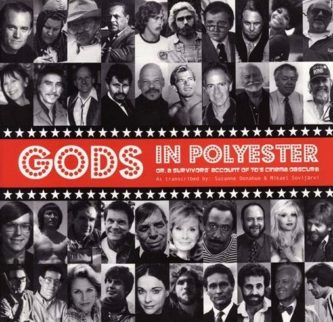 Edited By SUZANNE DONAHUE, MIKAEL SOVIJARVI (Succubus Press; 2004)
Edited By SUZANNE DONAHUE, MIKAEL SOVIJARVI (Succubus Press; 2004)
One of the greatest (and most difficult to locate) film books of the ‘00s was this massive collection of first-person recollections by participants in the horror-exploitation movie scene of the 1970s. Certainly a fair amount of documentation already exists about seventies-sploitation cinema, but I can guarantee that most of the stories told in this book are accounts you haven’t heard before, and they’re all contained in a unique, visually pleasing layout. GODS IN POLYESTER, in short, is a true treasure-trove for trash film enthusiasts (as is its sequel, the even more obscure GODS IN SPANDEX).
The recollections range from the detailed and expansive—as in the contributions by actor Bruce Glover, who in his writings about the WALKING TALL flicks includes plenty of miscellaneous autobiographical tidbits—to the VERY brief, as in actor Richard Harrison’s two sentence piece about something called THE TWINS: “I don’t remember this film. I probably put a couple of actors in it then sold it.”
Richard Harrison can be said to be the “star” of the book, having been an extremely prolific presence in exploitation films during the 1970s, about which he provides quite a few lively write-ups. Other frequently heard voices include those of actor George “Buck” Flower, who appeared in nearly as many seventies-sploiters as Harrison; Hy Pike, who graced a number of the decade’s most iconic trash epics (including LEMORA, DOLEMITE and THE FIRST NUDIE MUSICAL); and Carol Speed, who writes about acting in several famous Blaxploitation flicks.
Also included is a thrice-welcome essay by director John Hancock about the making of his classic fright fest LET’S SCARE JESSICA TO DEATH. Filmmaker Jeff Lieberman chooses to highlight some funny anecdotes that occurred during the shooting of his films BLUE SUNSHINE, SQUIRM and JUST BEFORE DAWN, while director George Barry, in writing about the long-suppressed DEATH BED, devotes more ink to the recent rediscovery of the film than he does to its production.
The late Donald G. Jackson, who helmed the anti-classic THE DEMON LOVER, offers a blunt retort to the infamously corrosive making-of documentary DEMON LOVER DIARY, gleefully recalling how he fired its makers from the production of THE DEMON LOVER, “which is caught by their own camera, as they drive away with my bullets flying in their direction.” Filmmaker Gary Graver writes about his bowdlerized actioner TEXAS LIGHTNING, of which he promises a director’s cut DVD will soon be made available. William Shatner even provides a brief reminiscence about his appearance in the grade-Z psychofilm IMPULSE (and includes a most memorable contributor bio that reads, simply, “William Shatner is William Shatner”).
The era of low budget filmmaking detailed in this book may be gone, but its echoes remain. In fact, the tales recounted in these pages, of struggling against woefully inadequate budgets, underwritten scripts and set-in-stone release dates, sound remarkably like what the makers of today’s Hollywood blockbusters go through. Even the subject matter of these films—rampaging monsters, aliens, superheroes—has been appropriated by mainstream Hollywood, which can be seen to portend any number of things, none of them positive.
